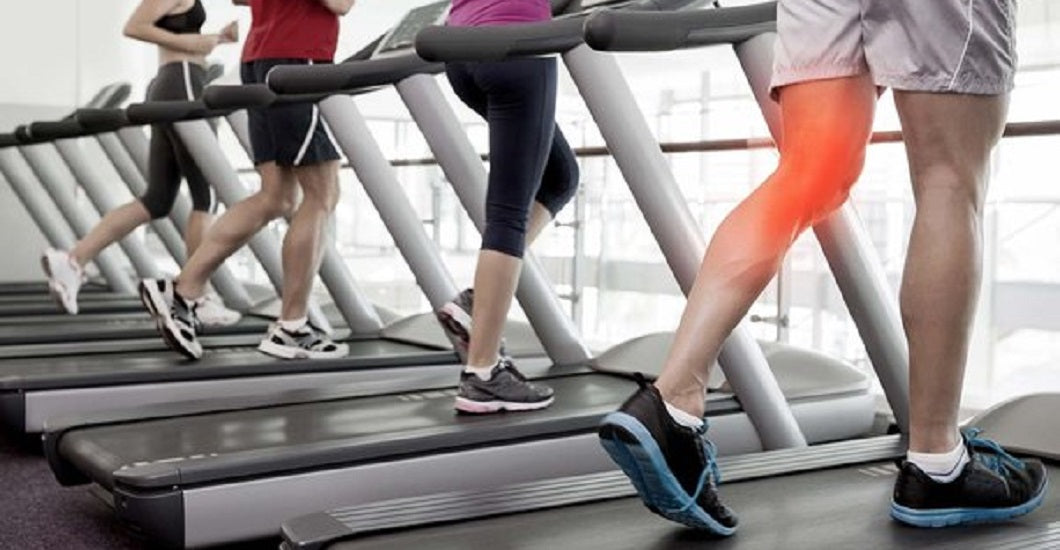When it comes to maintaining a healthy lifestyle, exercise is undoubtedly a key component. Among the myriad of exercise options available, the treadmill has long been a popular choice for cardio enthusiasts and those looking to shed a few pounds. However, a persistent concern has haunted the minds of many treadmill users: Are treadmills bad for your knees? Today SupeRun delves into this question to provide you with a comprehensive analysis that will help you make informed decisions about your fitness routine.
Misconceptions often cloud the discussion around treadmills and their impact on knee health. Some claim that the repetitive pounding of feet on a moving belt can lead to long-term joint damage, while others argue that treadmill running offers a controlled environment that is gentler on the knees than outdoor terrain. In this article, we aim to separate fact from fiction, empowering you with accurate information to guide your exercise choices.
Balancing exercise and joint health is crucial for maintaining an active lifestyle throughout life. With knee injuries and joint discomfort being common concerns, understanding how different forms of exercise, such as treadmill running, can affect your knees is vital. We believe that an informed approach to fitness can help you enjoy the benefits of regular exercise while safeguarding the long-term health of your joints.
The Impact of Treadmill Running on Knee Health
Mechanics of Treadmill Running
Stride Length and Impact
The stride length and its impact on knee health are essential considerations when exploring the mechanics of treadmill running. Stride length refers to the distance covered with each step while running. On a treadmill, the fixed surface and the moving belt dictate your stride length, which can vary from person to person.
- Impact on Knee Joints:
A shorter stride length on a treadmill may result in a higher cadence (more steps per minute), which could lead to increased impact forces on the knees. Conversely, an excessively long stride can strain the knees, as it may cause overextension or landing with a straight leg. Finding the right balance in stride length is crucial to reduce the stress on your knee joints during treadmill running.
Shock Absorption Systems
Modern treadmills are equipped with various shock absorption systems designed to mitigate the impact on your joints.
- Cushioning:
Most treadmills feature cushioning systems in the running deck, which help absorb some of the shock when your foot makes contact with the belt. High-quality treadmills often offer adjustable cushioning settings, allowing you to tailor the level of impact absorption to your preference.
- Deck Flexibility:
The flexibility of the treadmill deck plays a role in reducing knee impact. A flexible deck can provide a softer landing and a more forgiving surface, which can be gentler on the knees. It's important to note that the level of deck flexibility varies among treadmill models.
- Shock Absorbers:
Some treadmills incorporate specialized shock absorbers or elastomers in the design, further enhancing their ability to reduce impact on the knees and other joints. These systems aim to mimic the feel of outdoor running on a forgiving surface.
Understanding the shock absorption capabilities of your treadmill is crucial, as it directly affects how your knees absorb the forces generated during running. A treadmill with effective shock absorption can provide a more joint-friendly experience, reducing the risk of knee discomfort or injury.

Potential Stress on Knee Joints
Impact of Poor Form
The impact of running form on knee health cannot be overstated, whether you're on a treadmill or running outdoors. Poor running form can significantly increase the stress on your knee joints during each stride.
- Overstriding:
Overstriding occurs when your foot lands too far in front of your body. This places excessive stress on your knees, as the joint has to absorb a sudden and jarring impact. On a treadmill, where stride length may be constrained, overstriding is less common, but it can still occur if you're not paying attention to your form.
- Incorrect Foot Placement:
Landing with improper foot placement, such as a heel strike, can transmit shock directly to the knee joint. A heel strike can be exacerbated on a treadmill if you're not maintaining proper form.
- Lack of Core Engagement:
Weak core muscles can lead to poor posture and form while running. This can result in increased stress on the knees and other joints. It's essential to engage your core muscles to maintain an upright posture and distribute the load more evenly.
Overuse Injuries
Overuse injuries are a common concern among runners, including those who use treadmills regularly. These injuries often result from repetitive stress on the same muscles and joints without adequate rest and recovery.
- Common Overuse Injuries:
Overuse injuries that can affect the knees include patellofemoral pain syndrome (runner's knee), iliotibial (IT) band syndrome, and patellar tendinitis. These conditions can develop gradually, causing knee pain and discomfort over time.
- Treadmill Running and Overuse:
Treadmill running, due to its convenience and controlled environment, may lead some individuals to overuse their knees without realizing it. The consistent surface and ease of adjusting speed can encourage longer and more frequent workouts, potentially increasing the risk of overuse injuries if not managed appropriately.
To mitigate the potential stress on your knee joints while using a treadmill, it's crucial to prioritize proper running form, maintain strong core muscles, and be mindful of any signs of overuse or discomfort. Regularly varying your workouts, incorporating strength training, and listening to your body are essential strategies for preventing knee-related issues during treadmill running.

Factors Influencing Knee Health
Age and Joint Health
Age plays a significant role in knee health, and as we get older, our joints tend to undergo natural wear and tear. Understanding the relationship between age and knee health is crucial when considering treadmill running.
- Cartilage Degeneration:
With age, the cartilage in the knee joint may start to deteriorate, leading to reduced shock absorption and cushioning. This can make older individuals more susceptible to knee discomfort or injury, especially during high-impact activities like running.
- Muscle Strength:
Aging can also result in a gradual loss of muscle mass and strength, which can affect joint stability. Weakened muscles around the knee joint may fail to provide adequate support and protection during treadmill running.
Pre-existing Conditions
The presence of pre-existing knee or joint conditions can significantly impact your ability to run on a treadmill safely.
- Arthritis:
Individuals with osteoarthritis or rheumatoid arthritis may experience joint pain, stiffness, and inflammation. Running on a treadmill can exacerbate these symptoms and lead to increased discomfort.
- Previous Injuries:
Past knee injuries, such as ligament tears or meniscus injuries, can weaken the joint and make it more susceptible to further damage. Treadmill running may need to be approached with caution for those with a history of knee injuries.
- Body Weight:
Excess body weight places additional stress on the knee joints. If you are overweight or obese, treadmill running can potentially worsen knee issues or increase the risk of developing them.
Running Surface
The surface on which you run, whether on a treadmill or outdoors, has a significant impact on your knee health.
- Treadmill Surface:
Treadmill belts typically offer consistent and shock-absorbing surfaces, which can be gentler on the knees compared to uneven outdoor terrain. However, the effectiveness of shock absorption can vary between treadmill models, so choosing a treadmill with good cushioning is important.
- Outdoor Terrain:
Running on outdoor surfaces can range from soft and forgiving, like grass or trails, to hard and unforgiving, like concrete or asphalt. Softer terrains tend to be more joint-friendly, whereas running on hard surfaces can increase the impact on your knees.
Considering your age, any pre-existing knee conditions and the choice of running surface is essential in maintaining knee health during treadmill workouts. It's advisable to consult with a healthcare professional or a physical therapist if you have concerns about how these factors may affect your ability to use a treadmill safely. In the subsequent sections, we will explore the benefits of treadmill running for knee health and provide tips for protecting your knees during treadmill workouts.

Benefits of Treadmill Running for Knee Health
Controlled Environment
Consistent Surface
One of the advantages of treadmill running for knee health is the consistency of the running surface. Unlike outdoor running, where terrain can vary widely from one route to another, treadmills provide a uniform and predictable surface.
- Reduced Variability:
Treadmills offer a smooth and even surface, which can help reduce the risk of sudden and unexpected changes in terrain. This consistency minimizes the chances of awkward landings or unexpected twists that could stress the knees.
- Enhanced Predictability:
With a treadmill, you can anticipate the surface conditions, allowing for better control of your stride and foot placement. This predictability is especially beneficial for individuals concerned about their knee health, as it reduces the likelihood of missteps that can lead to injuries.
Adjusting Speed
Treadmills offer the unique advantage of allowing users to precisely control their workout parameters, including speed.
- Gradual Progression:
You can start at a comfortable pace and gradually increase both speed and incline as your fitness level improves. This gradual progression minimizes the risk of overloading your knee joints and helps you build strength and endurance over time.
- Customized Workouts:
Treadmills also offer a variety of workout programs, including interval training workouts. These programs can be tailored to your specific fitness goals and adapted to your knee comfort levels.
- Reduced Impact with Incline:
Inclining the treadmill surface slightly can reduce the impact on your knees by altering the way your foot lands. This can be particularly beneficial for those with knee concerns, as it distributes the forces differently.
The controlled environment of a treadmill, with its consistent surface and adjustable settings, allows users to tailor their workouts to their individual needs and comfort levels. This adaptability can be valuable for individuals seeking to protect their knees while still enjoying the benefits of cardiovascular exercise.
Rehabilitation and Injury Prevention
Low-Impact Options
For individuals with knee concerns or those recovering from knee injuries, low-impact exercise options are a valuable component of rehabilitation and injury prevention. Treadmills offer several low-impact features that can aid in knee rehabilitation:
- Walking:
Treadmills allow users to walk at a controlled pace, which is a low-impact exercise that puts less stress on the knees compared to running. Walking can help maintain cardiovascular fitness while gradually rebuilding strength and flexibility in the knee joint.
- Incline Walking:
Incline walking on a treadmill can further reduce the impact on the knees. It engages the muscles around the knee joint and can be an effective way to build strength and stability without subjecting the knees to high-impact forces.
- Customized Workouts:
Many treadmills offer preset programs that include low-impact workouts designed to minimize stress on the joints. These programs may incorporate intervals, varying speeds, and incline settings to create a knee-friendly exercise experience.
Gradual Progression
Gradual progression is a fundamental principle for both rehabilitation and injury prevention. Treadmills provide a controlled environment where you can carefully manage the intensity of your workouts to ensure knee health:
- Start Slow:
If you're recovering from a knee injury or have knee concerns, it's essential to begin at a slow and comfortable pace. Gradually increase your speed, duration, or incline as your knee strength and flexibility improve.
- Listen to Your Body:
Pay close attention to how your knees feel during and after treadmill sessions. If you experience pain, discomfort, or swelling, it's crucial to rest and consult with a healthcare professional. Ignoring warning signs can exacerbate knee issues.
- Cross-Training:
Incorporating cross-training activities, such as swimming or cycling, alongside treadmill workouts can help diversify your exercise routine and reduce the risk of overuse injuries. Cross-training allows you to engage different muscle groups while giving your knees a break from repetitive impact.
By incorporating low-impact options and focusing on gradual progression, individuals can use treadmills as a valuable tool for knee rehabilitation and injury prevention. These strategies can help maintain fitness levels while prioritizing the long-term health and well-being of the knee joints.

Tips for Protecting Your Knees on a Treadmill
Proper Running Form
- Foot Placement:
Ensure your foot lands under your hips and not too far in front of your body. Overstriding can increase the impact on your knees. Focus on a midfoot or forefoot strike, which is generally gentler on the joints compared to a heel strike.
- Stride Length:
Maintain a natural and comfortable stride length. Avoid overextending your legs or taking overly short steps. Finding the right balance can help reduce stress on the knees.
- Posture:
Maintain good posture while running on the treadmill. Keep your back straight, shoulders relaxed, and your head in a neutral position. Engaging your core muscles can help stabilize your upper body and distribute the load more evenly, reducing the strain on your knees.
Warm-Up and Cool-Down
Always begin your treadmill workouts with a proper warm-up. Spend 5-10 minutes walking at a slower pace to increase blood flow to your muscles and prepare your joints for exercise. After your workout, cool down by gradually reducing your speed and incorporating gentle stretching exercises to improve flexibility and prevent stiffness.
Shoe Selection
Choose the right pair of running shoes that provide adequate cushioning and support. Properly fitting shoes can help absorb shock and reduce the impact on your knees. Consider consulting with a footwear expert or a podiatrist to ensure you're wearing shoes that are suitable for your specific foot shape and running style.
Cross-Training
Incorporate cross-training into your fitness routine to give your knees a break from the repetitive impact of treadmill running. Activities like swimming, cycling, or strength training can help maintain overall fitness while reducing the risk of overuse injuries.
Listening to Your Body
Pay attention to any signs of discomfort, pain, or swelling in your knees during and after treadmill workouts. If you experience persistent knee issues, consult with a healthcare professional or a physical therapist for guidance. Ignoring knee pain can lead to more severe injuries.
By following these tips and prioritizing proper running form, warm-up and cool-down routines, suitable footwear, and a well-rounded fitness regimen, you can protect your knees while reaping the benefits of treadmill exercise.
Conclusion
Treadmills offer numerous advantages, such as a controlled environment, consistent surfaces, and adjustable settings, which can be beneficial for individuals of varying fitness levels and knee conditions. When used correctly, treadmills can provide effective workouts while minimizing the risk of knee discomfort or injury.
The key to protecting your knees during treadmill exercise lies in understanding the mechanics of running, maintaining proper form, and making informed choices. Strategies like gradual progression, incorporating low-impact workouts, and cross-training can help safeguard knee health and ensure a sustainable fitness routine.
In conclusion, treadmills can be a valuable tool for maintaining overall fitness and cardiovascular health, even for those with knee concerns. By combining the benefits of treadmill running with proper technique, thoughtful planning, and a holistic approach to knee health, you can continue to enjoy the many advantages of this versatile exercise modality while safeguarding the well-being of your knees. Ultimately, a balanced and informed approach to exercise is the key to achieving your fitness goals while preserving your knee health for the long term.






Leave a comment
All comments are moderated before being published.
This site is protected by reCAPTCHA and the Google Privacy Policy and Terms of Service apply.